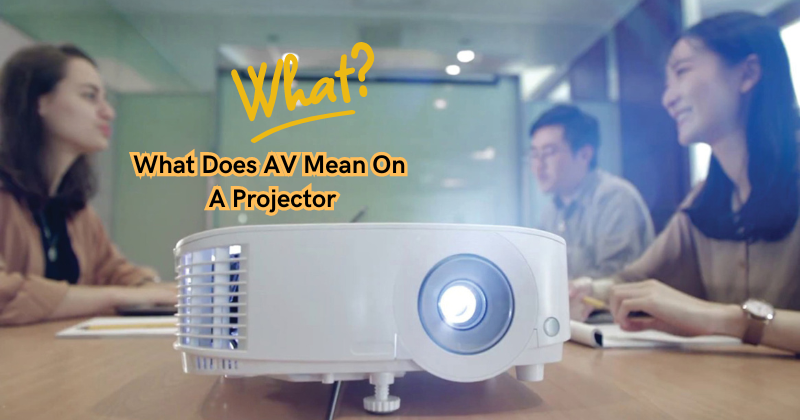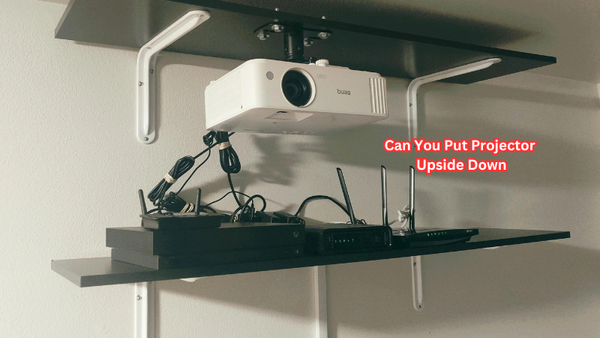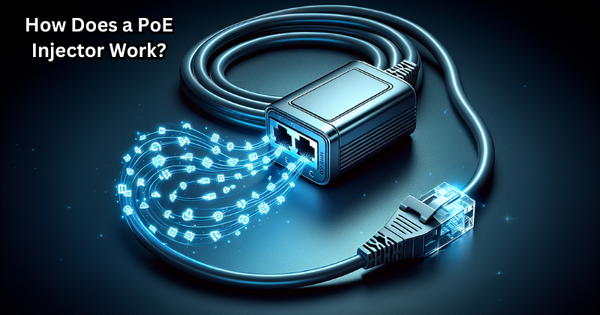"AV" on a projector typically stands for "Audio-Visual," encompassing both the visual display and sound components.
In the context of a projector, the "AV" input refers to the port or connection point designated for transmitting both video and audio signals from external devices.
This allows users to connect various multimedia sources, such as laptops, DVD players, gaming consoles, and more, to the projector for seamless audio-visual presentations or entertainment.
Understanding the functionality of the "AV" input on a projector is crucial for harnessing its full potential in delivering immersive audio-visual experiences across different settings, from classrooms and conference rooms to home theaters and event spaces.
In this article, we will delve into the details of what "AV" means on a projector, including its various types and uses.
Types of AV Ports
There are various types of AV ports available on projectors, each with its unique features and functions.
- HDMI (High Definition Multimedia Interface) - This is the most commonly used AV port on modern projectors and supports high-definition audio and video signals simultaneously. It provides a single cable connection for transmitting uncompressed digital data from sources such as laptops, Blu-ray players, and gaming consoles to the projector. HDMI ports come in different versions, with each version offering higher bandwidth and, thus, better video and audio quality.
- VGA (Video Graphics Array) - This is an older type of AV port that supports analog signals and is commonly found on older projectors. It can transmit only video signals and requires a separate audio cable for sound transmission. VGA ports have mainly been replaced by HDMI in modern projectors due to their limitations in terms of video quality and compatibility with newer devices.
- Composite Video - This is a standard AV port that transmits analog video signals and requires separate audio cables for sound transmission. It is commonly used in older devices such as VCRs, DVD players, and game consoles.
- Component Video - This AV port transmits high-quality analog video signals, divided into three separate channels for luminance (brightness) and two color components (red and blue). It also requires different audio cables for sound transmission. Component video is commonly found on DVD players and some gaming consoles.
- S-Video (Separate Video) - This is a high-quality AV port that transmits analog video signals, split into two separate channels for luminance and chrominance (color). It also requires different audio cables for sound transmission. S-Video is commonly used in older devices such as VCRs and DVD players but has been largely replaced by HDMI in modern projectors.
What Does AV Mean On A Projector?
Now that we have discussed the various types of AV ports let's get back to our main question - what does "AV" mean on a projector? In simple terms, "AV" stands for Audio-Visual and refers to the capability of projectors to transmit both video and audio signals.
The "AV" input is typically labeled as such or may also be referred to as "AV in" or "audio/video in." This input allows users to connect external devices and transmit their audio-visual content onto the projector screen. AV output, on the other hand, refers to the signal output from the projector's built-in speakers or audio out port.
In addition to the various types of AV ports, some projectors also come with built-in speakers, allowing for an all-in-one audio-visual solution without the need for separate external speakers.
However, these built-in speakers may provide poor sound quality and are usually designed for small, intimate settings. For more significant events or spaces, it is recommended to connect external speakers to achieve better audio output.
How to Use the AV Input on a Projector
To use the "AV" input on a projector, follow these steps:
- Identify the type of AV port on your projector and locate it. It is usually labeled as "AV," "HDMI," or with the corresponding color (red, white, yellow) for composite video.
- Connect one end of the appropriate cable (HDMI, VGA, composite, etc.) to the AV port on your projector and the other end to the corresponding output port on your device.
- If using an audio cable, connect one end to the audio output port on your device and the other end to the designated audio input port on your projector.
- Power on both your projector and the connected device.
- Select the AV input source on your projector using the remote control or on-screen menu. This may be labeled as "AV," "Input," or with a corresponding number (HDMI 1, HDMI 2, etc.).
- Adjust the audio and video settings on your projector and device to optimize the output quality according to your preferences.
- Start playing the content on your device, and it should be displayed on the projector with accompanying audio if connected correctly.
AV cable connections may vary depending on the type of projector and devices used, so it is always recommended to check the user manual for specific instructions. But nowadays, many modern projectors offer wireless connectivity options, eliminating the need for AV cables.
Exploring Essential AV Equipment
As mentioned earlier, understanding the functionality of the "AV" input on a projector is crucial for delivering immersive audio-visual experiences.
However, to achieve optimal results, it is also essential to have suitable AV systems. Here are some crucial pieces of AV equipment that can enhance your overall audio-visual experience when using a projector:
Audio Cables:
- HDMI cable - to transmit high-quality digital audio signals from devices such as laptops, Blu-ray players, and gaming consoles.
- RCA cables - use these for composite video connections where separate audio cables are required.
- 3.5mm audio jack - commonly used for connecting laptops, smartphones or MP3 players to projectors for sound transmission.
Video Cables:
- HDMI cable - for high-definition video and audio transmission. AV cables are also available for this purpose.
- VGA cable - used for transmitting analog video signals from older devices to projectors.
- Component video cables - preferred for transmitting high-quality analog video signals.
Other AV Equipment:
- Projector screen - this is essential for displaying the projected image with optimum brightness, contrast, and color accuracy. Image quality may be compromised if projected onto a subpar surface.
- Mounting brackets - to securely install the projector in a fixed location.
- Speakers - for enhanced audio output and can be connected directly to the projector or through a separate amplifier.
- Amplifiers - used to boost audio signals for more significant events or spaces.
- Audio mixers - allow for multiple audio sources to be combined and adjusted before being transmitted to the projector.
- Adapters and converters - to convert signals between different types of AV ports, ensuring compatibility between devices.
Audio and visual elements play a significant role in enhancing the overall experience of presentations, events, and home entertainment.
Benefits of Using the AV Input on a Projector
Using the "AV" input on a projector has several benefits, including:
- Versatility - the ability to connect multiple devices and transmit both video and audio signals provides users with more options for displaying their content.
- Convenience - using one cable to transmit both audio and video signals reduces clutter and simplifies setup.
- Quality - depending on the equipment used, using the "AV" input can result in high-quality audio and video output. Poor sound quality from sound system components can negatively impact the overall experience, and using the AV input eliminates this issue.
- Compatibility - most modern projectors come equipped with multiple AV ports, ensuring compatibility with a wide range of devices.
- Cost-effective - having one input for both audio and video means fewer cables and adapters are needed, resulting in cost savings.
- Ease of use - using the "AV" input is generally straightforward and does not require extensive technical knowledge.
FAQs
What is an AV cable for a projector?
An AV cable for the projector is a cable used to transmit audio and video signals from a device, such as a laptop or DVD player, to the projector. It typically includes both an audio and video component, hence the term "AV," which stands for audio-visual. These cables are essential for connecting devices to projectors in order to display content with accompanying sound.
Is a projector considered AV?
Yes, a projector is considered AV because it can receive both audio and video signals from devices through its "AV" input ports. The term "AV" refers to the transmission of both audio and visual elements, which is what projectors are designed to do. AV technology has significantly advanced in recent years, making projectors an essential tool for delivering high-quality audio-visual presentations and entertainment.
Is AV better than HDMI?
It depends on the specific needs and preferences of the user. HDMI cables are typically used for high-definition digital video and audio transmission, while AV cables can support both analog and digital signals.
Do you need an AV receiver for a projector?
It depends on the specific setup and equipment being used. An AV receiver is only sometimes necessary for a projector, as it can be connected directly to other devices such as laptops or DVD players.
Conclusion
Understanding the significance of "AV" on a projector is paramount in harnessing its full potential for immersive audio-visual experiences.
The term "AV" primarily denotes "Audio-Visual," encompassing both the visual display and sound components. It serves as an interface for connecting various multimedia devices, such as DVD players, computers, gaming consoles, and more, enabling the seamless transmission of audio and video signals.
This integration allows for captivating entertainment experiences and effective presentations in diverse settings, including classrooms, boardrooms, home theaters, and event venues.
By comprehending the role of "AV" inputs on projectors, users can leverage this functionality to create engaging visual displays coupled with high-quality audio, ensuring a compelling and enriching experience for both personal and professional applications.





